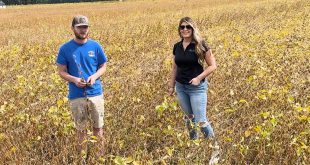In early-planted soybean fields with cold and wet soils, seeding diseases like soybean sudden death syndrome (SDS) can have an economically significant e ect on yields. In 2014, for example, our team found 20 percent yield losses attributed to SDS in some fields. Addressing SDS and its triggers early can minimize the disease’s impact.
Primarily, SDS stems from the Fusarium virguliforme pathogen, which may overwinter in soybean cyst nematode cysts, crop residues or the soil itself. Several conditions can increase SDS risk. Soybean fields with Fusarium pathogen infection; soybean cyst nematode pressure; or cool, wet and compacted soils all would have higher SDS susceptibility.
With the Fusarium pathogen present, it can attack seedling roots and stem tissue near the soil surface. It produces toxins that migrate through the stem and into the soybean canopy. SDS can begin at germination, but symptoms aren’t apparent until the reproductive stage. By that point, yield losses are inevitable.
Producers have had few options for addressing SDS. Crop rotation doesn’t e ectively mitigate the disease, and applying conventional fungicides post-infection isn’t e ective. Some soybean varieties may have some SDS resistance, but such varieties can be limited.
To reduce SDS risk this year, we recommend applying our BPIF-Soy in-furrow treatment at planting. Placing the treatment near germinating seed is critical to effectively managing SDS. Designed to address SDS, BPIF-Soy blends a crop biological and cold-processed sweetener. The biological features multiple beneficial bacteria that can suppress nematodes and fungal pathogens, encourage early growth and promote soil health. The cold-processed sweetener facilitates a quick soybean growth habit.
Contact us at 816-773-6018 to learn more about minimizing the SDS impact in your soybean fields.
 BigYield High Yield Soybeans, High Yield Corn, and High Yield Wheat
BigYield High Yield Soybeans, High Yield Corn, and High Yield Wheat



